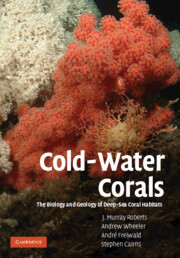5 - Habitats and ecology
Published online by Cambridge University Press: 23 December 2009
Summary
In a band somewhat restricted in depth, extending downwards from the 100-fathom line, we met in some places with very large numbers of many varieties of Caryophyllia borealis, FLEMING; and at depths of 300 to 600 fathoms the handsome branching Lophohelia prolifera PALLAS forms stony copses covering the bottom for many miles, the clefts of its branches affording fully appreciated shelter to multitudes of Arca nodulosa, Psolus squamatus, Ophiopholis aculeata and other indolent ‘commensals’.
The Depths of the Sea Charles Wyville Thomson (1874)The habitat-forming capacities of corals have fascinated generations of marine biologists. Shallow-water tropical coral reefs, so often called the ‘rainforests of the sea’, are home to the greatest vertebrate biodiversity on the planet with over 4000 species of reef fish in 179 families estimated to be found in the Indo-Pacific region alone (Myers, 1989). The ability of one species to provide habitat for others has been formalised through the concept of ‘ecological engineering’ (Jones et al., 1994; Wright & Jones, 2006) and we discuss this in relation to cold-water corals and some of their symbiotic associates later in this chapter. Different cold-water coral species develop habitats of varying physical sizes and life spans. For instance, gorgonians may grow close together, forming dense forest-like habitats, but after death these colonies will break down, unlike the reef frameworks left by colonial scleractinians that were discussed in the last chapter.
- Type
- Chapter
- Information
- Cold-Water CoralsThe Biology and Geology of Deep-Sea Coral Habitats, pp. 142 - 174Publisher: Cambridge University PressPrint publication year: 2009
- 1
- Cited by

